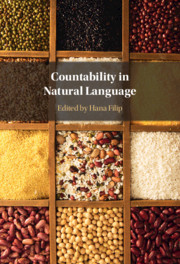Book contents
- Countability in Natural Language
- Countability in Natural Language
- Copyright page
- Contents
- Contributors
- Preface
- Introduction
- 1 Proportional Many/Much and Most
- 2 Quantity Systems and the Count/Mass Distinction
- 3 Counting Aggregates, Groups and Kinds: Countability from the Perspective of a Morphologically Complex Language
- 4 Individuating Matter over Time
- 5 Reduplication as Summation
- 6 Iceberg Semantics for Count Nouns and Mass Nouns: How Mass Counts
- 7 Indexical Inference: Counting and Measuring in Context
- 8 Counting and Measuring and Approximation
- 9 The Count/Mass Distinction for Granular Nouns
- Index
- References
5 - Reduplication as Summation
Published online by Cambridge University Press: 11 June 2021
- Countability in Natural Language
- Countability in Natural Language
- Copyright page
- Contents
- Contributors
- Preface
- Introduction
- 1 Proportional Many/Much and Most
- 2 Quantity Systems and the Count/Mass Distinction
- 3 Counting Aggregates, Groups and Kinds: Countability from the Perspective of a Morphologically Complex Language
- 4 Individuating Matter over Time
- 5 Reduplication as Summation
- 6 Iceberg Semantics for Count Nouns and Mass Nouns: How Mass Counts
- 7 Indexical Inference: Counting and Measuring in Context
- 8 Counting and Measuring and Approximation
- 9 The Count/Mass Distinction for Granular Nouns
- Index
- References
Summary
Lam’s chapter analyses the phenomenon of reduplication, primarily in Cantonese, a language in which reduplication can occur in the nominal domain, usually on the classifier, to express plurality, in the verbal domain to express an iteration of eventualities or a prolongation of an eventuality, and in the adjectival domain to express property attenuation. Lam argues for a uniform treatment of reduplication in terms of summation and a sensitivity to whether the replicated elements are (strictly) quantized or cumulative. For example, entity-denoting nominal classifiers, and verbal predicates denoting quantized sets of eventualities (such as tiu3 ‘jump’) denote pluralities or iterations, respectively, based on the summing of entities/eventualities. For verbal expressions that denote cumulative predicates (such as fan3 ‘sleep’), summation adds up ‘portions’ of unbounded, overlapping eventualities forming one temporally extended eventuality. Lam proposes that Cantonese bare adjectives denote dimensions, e.g. tallness, but not degree or magnitude. This nullifies any semantic effect of summation, and the attenuation effect is derived via competition with other forms using hou2 (‘very’).
Information
- Type
- Chapter
- Information
- Countability in Natural Language , pp. 145 - 160Publisher: Cambridge University PressPrint publication year: 2021
References
Accessibility standard: Unknown
Why this information is here
This section outlines the accessibility features of this content - including support for screen readers, full keyboard navigation and high-contrast display options. This may not be relevant for you.Accessibility Information
- 1
- Cited by
